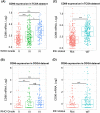CD96, a new immune checkpoint, correlates with immune profile and clinical outcome of glioma
- PMID: 32612110
- PMCID: PMC7330044
- DOI: 10.1038/s41598-020-66806-z
CD96, a new immune checkpoint, correlates with immune profile and clinical outcome of glioma
Abstract
CD96 is a promising candidate for immunotherapy. However, its role and importance in glioma remains unknown. We thus aimed to genetically and clinically characterize CD96 expression in gliomas. For this, we extracted RNA-seq data of 699 glioma samples from the TCGA dataset and validated these findings using the CGGA dataset comprising 325 glioma samples. Clinical and isocitrate dehydrogenase (IDH) mutation status were also analyzed. Various packages in R language were mainly used for statistical analysis. CD96 expression was significantly up-regulated in high-grade, IDH-wildtype, and mesenchymal-molecular subtype gliomas based on TCGA data, which was validated using the CGGA dataset. Subsequent gene ontology analysis of both datasets suggested that genes relevant to CD96 are mainly involved in immune functions in glioma as such genes were positively correlated with CD96 expression. To further explore the relationship between CD96 and immune responses, we selected seven immune-related metagenes and found that CD96 expression was positively correlated with HCK, LCK, and MHC II in the CGGA and TCGA cohorts but negatively associated with IgG. Further, Pearson correlation analysis showed that CD96 is associated with TIGIT, CD226, CRTAM, TIM-3, PD-L1, CTLA-4, and STAT3, indicating the additive antitumoral effects of these checkpoint proteins. CD96 was also suggested to play an important role in immune responses and positively collaborate with other checkpoint members. These findings show that CD96 is promising candidate for immunotherapy, and that such agents could complement current immunotherapy strategies for glioma.
Conflict of interest statement
The authors declare no competing interests.
Figures







Similar articles
-
Immune and Clinical Features of CD96 Expression in Glioma by in silico Analysis.Front Bioeng Biotechnol. 2020 Jun 30;8:592. doi: 10.3389/fbioe.2020.00592. eCollection 2020. Front Bioeng Biotechnol. 2020. PMID: 32695752 Free PMC article.
-
Molecular and clinical characterization of PTPN2 expression from RNA-seq data of 996 brain gliomas.J Neuroinflammation. 2018 May 15;15(1):145. doi: 10.1186/s12974-018-1187-4. J Neuroinflammation. 2018. PMID: 29764444 Free PMC article.
-
Large-scale analysis reveals the specific clinical and immune features of CD155 in glioma.Aging (Albany NY). 2019 Aug 4;11(15):5463-5482. doi: 10.18632/aging.102131. Epub 2019 Aug 4. Aging (Albany NY). 2019. PMID: 31377744 Free PMC article.
-
TIGIT and CD96: new checkpoint receptor targets for cancer immunotherapy.Immunol Rev. 2017 Mar;276(1):112-120. doi: 10.1111/imr.12518. Immunol Rev. 2017. PMID: 28258695 Review.
-
CD96 as a Potential Immune Regulator in Cancers.Int J Mol Sci. 2023 Jan 9;24(2):1303. doi: 10.3390/ijms24021303. Int J Mol Sci. 2023. PMID: 36674817 Free PMC article. Review.
Cited by
-
Genome Instability-Associated Long Non-Coding RNAs Reveal Biomarkers for Glioma Immunotherapy and Prognosis.Front Genet. 2022 Apr 27;13:850888. doi: 10.3389/fgene.2022.850888. eCollection 2022. Front Genet. 2022. PMID: 35571034 Free PMC article.
-
The Role of Natural Killer Cells in Soft Tissue Sarcoma: Prospects for Immunotherapy.Cancers (Basel). 2021 Jul 31;13(15):3865. doi: 10.3390/cancers13153865. Cancers (Basel). 2021. PMID: 34359767 Free PMC article. Review.
-
Next Generation Immuno-Oncology Strategies: Unleashing NK Cells Activity.Cells. 2022 Oct 6;11(19):3147. doi: 10.3390/cells11193147. Cells. 2022. PMID: 36231109 Free PMC article. Review.
-
A Ferroptosis-Related Gene Prognostic Index Associated With Biochemical Recurrence and Radiation Resistance for Patients With Prostate Cancer Undergoing Radical Radiotherapy.Front Cell Dev Biol. 2022 Feb 10;10:803766. doi: 10.3389/fcell.2022.803766. eCollection 2022. Front Cell Dev Biol. 2022. PMID: 35223835 Free PMC article.
-
Role of CD68 in tumor immunity and prognosis prediction in pan-cancer.Sci Rep. 2022 May 12;12(1):7844. doi: 10.1038/s41598-022-11503-2. Sci Rep. 2022. PMID: 35550532 Free PMC article.
References
-
- Wang PL, O’Farrell S, Clayberger C, Krensky AM. Identification and molecular cloning of tactile. A novel human T cell activation antigen that is a member of the Ig gene superfamily. The Journal of Immunology. 1992;148:2600–2608. - PubMed
-
- Blake, S. J. et al. Suppression of metastases using a new lymphocyte checkpoint target for cancer immunotherapy. Cancer discovery, CD-15-0944 (2016). - PubMed
Publication types
MeSH terms
Substances
LinkOut - more resources
Full Text Sources
Medical
Research Materials
Miscellaneous

